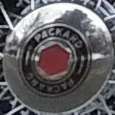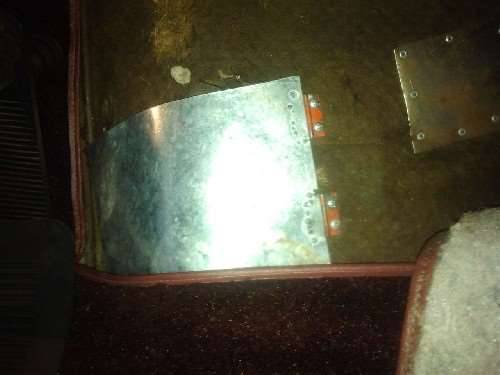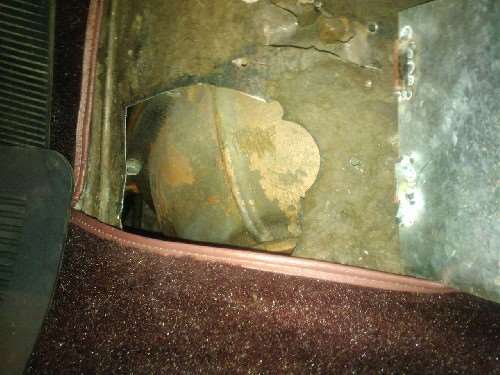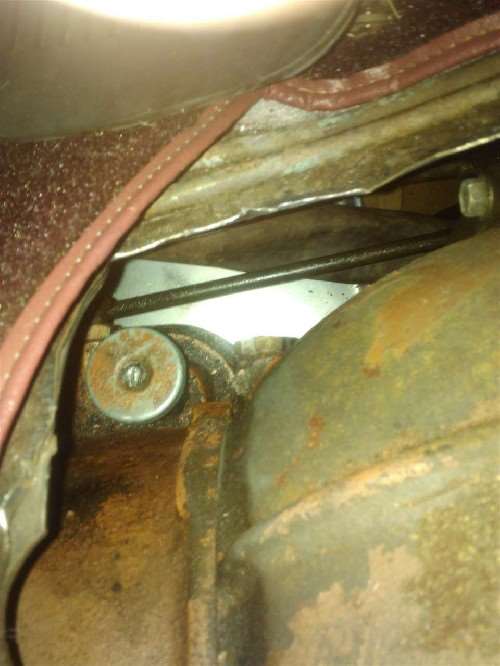|
Ping In 359 Engine
|
||||
|---|---|---|---|---|
|
Home away from home

|
My 1954 Convertible pings under load in warm temperatures. It usually starts pinging after it's been driven 10 miles or so and will start pinging sooner on the return trip, even after the engine has had a complete cool down. Curiously, in December I had it in a holiday parade, the ambient temperature was just below freezing. The car ran constantly for over 3 hours, traveled 20 miles and didn't ping once the whole time.
I use premium fuel and add a booster that supposedly raises the octane to 108. This seems to lessen the pinging but hasn't stopped it entirely. A friend recommended advancing the timing 2 degrees. I hadn't looked into that because it starts and runs so well aside from the pinging. Checking into this, I found that I have no timing indicator for the vibration dampner. The dampner has markings on it but they're useless. This looks to be only part of the problem as the power steering pump prevents me from holding a timing light where they show it in the shop manual. There's no mention of this in the manual, but the distributor mounting bracket has markings on it and the disrtributor mounting boss has a line scribed into it. The distributor is mounted at 6 degrees advance. If that's so, I don't think it would be wise to advance it further; perhaps it should be set to zero as per the specs. Maybe a mechanic was looking at the specs for the 327 which calls for 6 degrees BTDC and so set this up wrong. What do you think? I'm leery when what I see deviates so much from the information in the shop manual.
Posted on: 2014/4/23 17:36
|
|||
|
Don Shields
1933 Eight Model 1002 Seven Passenger Sedan 1954 Convertible |
||||
|
||||
|
Re: Polish aluminum engine
|
||||
|---|---|---|---|---|
|
Home away from home

|
Actually the cylinder blocks on these engines are iron, not aluminum. The crankcase and oil pan are cast aluminum with a somewhat stippled, non-reflective surface as supplied by the foundry. Packard left these castings unpainted and unpolished. Over the years a coating of oxide forms on these castings that darkens and dulls the surface. It can largely be removed with drill-mounted wire brushes with the engine still in the car. The wire brushing will leave the castings with a brighter but certainly not a polished-looking finish very much like newly-cast aluminum. Oxide will begin to re-form on the surface although it could be some time before it is highly visible. To prevent or at least slow down this oxide process, something like Eastwood's Diamond Clear finish for bare metal can be sprayed on the castings. I've seen a 1930 726 engine done this way, and it looked more authentic than the commonly-found aluminum-painted restorations. I wouldn't put any kind of coating on the inside of these castings.
Posted on: 2014/2/9 18:01
|
|||
|
Don Shields
1933 Eight Model 1002 Seven Passenger Sedan 1954 Convertible |
||||
|
||||
|
Re: 52-6 Fuel tanks
|
||||
|---|---|---|---|---|
|
Home away from home

|
Steve,
My '54 Convertible had a seepage problem where the fuel line exited the tank. That area had a repair done prior to my ownership. It looked like it was silver-soldered and then ground or filed smooth. The repair looked to be well done but gas would seep out, roll along the left side tank strap and drip onto the ground whenever the fuel level was high enough to contact that area. Like you, I tried various exterior repairs without success. But when I tried Seal-All, www.seal-all.com, I was pleasantly surprised as it actually worked! That was almost three years ago and there hasn't been a sign of a drip since. A side benefit is the garage doesn't smell like raw gas anymore when the tank is over half full. At the risk of sounding like an infomercial, I also used it successfully to stop seepage in a convertible top hydraulic hose where the flexible hose meets its' fitting. I also use it as a lubricant/sealant when plugging nail punctures in tires. It's a clear adhesive and sealant. I bought it at Pep Boys, but I've also seen it in hardware stores. It's not terribly expensive so it might be worth giving it a try before you drop the tank for repair or replacement.
Posted on: 2014/2/9 16:47
|
|||
|
Don Shields
1933 Eight Model 1002 Seven Passenger Sedan 1954 Convertible |
||||
|
||||
|
Re: '54 Rear Wheel Bearing Repack Oddities
|
||||
|---|---|---|---|---|
|
Home away from home

|
I owe O.D. a long-overdue note of thanks for his advice on this project, so thanks, O.D. You spurred me on to find a shim which I thought would be impossible to find. Bob's Packard Parts proved me wrong, he had one .007 shim that is now on the left side.
The right side repack went by the book, although pulling the inner seal was a problem. I went to 2 national chain auto supply stores and neither one had a puller for that seal nor a slide hammer with the screw extension. Attemps at prying the seal were unsuccessful, but I did get it out by chiseling through the seal's front and rear faces in a couple of places, weakening the seal's hold. The left side was not as cooperative. The shaft will not pull out. Using the hub as a slide hammer worked well on the right but not on the left. Again, a slide hammer with 7/8-14 female threaded end was not available. So I wound up lubricating the bearing using a needle extension on my grease gun. It fit in nicely at the innner race between each roller, and the old grease was pushed out. By the way, the old grease on both sides was not dry, caked or dirty, it actually looked quite fresh. I put the shim on this side so hopefully when making right turns the bearing cup will move, even if only .007 of an inch. That should bring end play within specs and might make it possible to pull the shaft the next time I'm in there.
Posted on: 2013/10/29 17:35
|
|||
|
Don Shields
1933 Eight Model 1002 Seven Passenger Sedan 1954 Convertible |
||||
|
||||
|
'54 Rear Wheel Bearing Repack Oddities
|
||||
|---|---|---|---|---|
|
Home away from home

|
In performing my first rear wheel bearing repack on my 1954 Convertible, I've encountered some oddities that I'd like to get advice & opinions on. The first oddity is that there is no discernable end play in either shaft. The second oddity is that there are no shims on either end of the axle tube. This led me to believe that the bearings might be damaged, although I was not hearing any noises or feeling anything that would suggest bad wheel bearings. Surprisingly, there is no visible damage to the right rear (haven't pulled the left side yet) rollers, cage, or outer race. I'm wondering if end play and shims are really that important.
Another oddity is the orientation of the inner seal. The old seal has the tapered end of the rubber "doughnut' facing inwards towards the differential. The new seal has a rather large groove in the face that I would have to drive if I orient the new seal the same way. This doesn't make sense to me; I think the drift should go against the broad flat face of the seal. So I'm wondering if the old seal is insalled incorrectly. I could also use some advice on how to remove the inner seals as I have no puller for that, and also if there are any tricks of the trade to reinstall the bearing cup or outer race. It looks like a mighty tight fit. Thanks.
Posted on: 2013/10/18 20:45
|
|||
|
Don Shields
1933 Eight Model 1002 Seven Passenger Sedan 1954 Convertible |
||||
|
||||
|
Re: Ultramatic trap door
|
||||
|---|---|---|---|---|
|
Home away from home

|
Responding to Howard's request, here are all the dimensions in inches:
The galvanized cover or door is 6 1/4" high X 9" wide. The door is clearly oversized but it also covers a hole nominally 1" X 1 1/4", visible in the second photo. Note there is also a 3" X 3 1/2" riveted panel visible in the upper right of the first photo, probably concealing yet another hole. I think all these holes, including the dipstick access, were originally cut to access the bell housing mounting bolts (you can see the hex head in the smaller hole that the door covers.) I don't know why this was done, maybe they had no shop manual? The dipstick access opening measures 5" high at the gas pedal side tapering irregularly to about 4" high X 6" wide. This opening is located 8 1/2" below the base of the stitched horizontal seam in the black inner firewall cover pad. This opening begins about 2 5/8" up from the toeboard floor level under the gas pedal. If you are thinking of making an opening like this, I would suggest making it smaller than this one, just large enough to comfortably fit your hand into it. That should also be large enough for a funnel when refilling the transmission. As seen in the third photo, the dipstick cap is located under the lower left corner of this opening. I would try to center the opening over the cap a little better than this if possible. Of course if this one was centered over the cap it might require some complicated bends in the door where it would be covering part of the lower hump area and carpet modifications to get access to the door. I hope this is helpful. To respond to Tim's comments, yes the opening is larger than it needs to be for the dipstick; keep in mind they seemed to be trying to get to the housing bolts first and may have enlarged it to get to the dipstick as an afterthought. Overall, I think the benefits of this modification outweigh its detriments. The transmission was completely rebuilt by the prior owner. It leaks very little, not nearly enough to justify a reseal.
Posted on: 2012/10/11 0:47
|
|||
|
Don Shields
1933 Eight Model 1002 Seven Passenger Sedan 1954 Convertible |
||||
|
||||
|
Re: Ultramatic trap door
|
||||
|---|---|---|---|---|
|
Home away from home

|
I've heard that many '51 through '54 Packards were "modified" like my '54 Convertible is (see attached photos.) This was on the car when I bought it seven years ago. The floor was rather crudely cut out, but it works. There is even enough room to use a funnel to add fluid. Something like this may be hiding under your carpet.
The floor carpeting is a kit I bought from Kanter. The carpeting over the upper part of the hump was left open on the left side. It just slips under the carpet edging that runs just beside the gas pedal area. This makes it easy to access the trap door. Hopefully, your carpeting is similarly constructed. Now if only there was an easy way to access the non-Easamatic brake master cylinder...
Posted on: 2012/10/10 19:09
|
|||
|
Don Shields
1933 Eight Model 1002 Seven Passenger Sedan 1954 Convertible |
||||
|
||||
|
Re: '54 shock absorber question...
|
||||
|---|---|---|---|---|
|
Home away from home

|
I have a '54 Convertible (see registry) and I put Kanter shocks on it about 5 years ago; I put their regular shocks on the front and air shocks on the back. The ones that were on it looked decades old and were completely shot. I also replaced the front and rear sway bar bushings as they were all cracked and pounded out of shape. The Kanter shocks seem to be OK to me, I felt a real difference in the ride and handling. But I still wasn't totally happy with the ride, it was harsh in the front over bumps and dips. Just about a year ago, I replaced the front springs (ordered them from Springs 'N Things) and what a difference that made! I'm sure those front springs were original, since they had the Packard part number stamped into them. I guess we can forgive them for wearing out after 57 years of service.
I know you mentioned that the rest of the suspension is up to snuff, but do you know if the front springs have ever been replaced? All I can say is it made a world of difference in my car's ride, and I've even stopped wincing over bumps and dips in the road! I hope this is helpful to you.
Posted on: 2012/6/29 0:58
|
|||
|
Don Shields
1933 Eight Model 1002 Seven Passenger Sedan 1954 Convertible |
||||
|
||||
|
Re: '54 Convertible E-brake Spring Mystery
|
||||
|---|---|---|---|---|
|
Home away from home

|
The '51 200 photo is very interesting. This 24th series car has the rare first design toggle that the bulletin that Howard posted refers to. Compare this photo with Fig. 1 of Howard's bulletin to see how much they changed it around.
Owen, that is the exact spring involved. You got a real deal on that spring, more like what I was thinking. Nice to see the complete specs on that spring. Thank you both for adding to this repository of information on Packard's toggle to handle spring.
Posted on: 2012/4/11 20:56
|
|||
|
Don Shields
1933 Eight Model 1002 Seven Passenger Sedan 1954 Convertible |
||||
|
||||

 (75.65 KB)
(75.65 KB)








